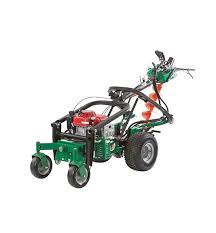 Is the engine in your Billy Goat running poorly? Are you having trouble getting the electric starter to work, even though the battery is fine? Maybe it’s time to look at your equipment’s electrical system. These tips will help you troubleshoot common problems, so you can get your equipment back to work.
Is the engine in your Billy Goat running poorly? Are you having trouble getting the electric starter to work, even though the battery is fine? Maybe it’s time to look at your equipment’s electrical system. These tips will help you troubleshoot common problems, so you can get your equipment back to work.
Check These Items First
These are the most common, easiest-to-check problems with small engine electrical systems:
Are all safety switches disengaged?
Your Billy Goat equipment may have a bail that needs to be closed or levers that need to be open for the engine to start. Make sure the cables for the controls are tensioned correctly and move smoothly when used. Stand-on blowers won’t start unless the operator is standing on the platform and the drive levers are in neutral.
Is there enough oil in the crankcase?
Most engines used by Billy Goat have a low oil sensor. When the float inside the crankcase gets too low, it cuts power to the ignition. This keeps you from running the engine and damaging it.
Are the spark plugs connected?
It’s good practice to disconnect the spark plug wires before working on your equipment. That way, if you spin the crankshaft, you won’t start the engine. Make sure you didn’t leave them disconnected after the repair.
How Does the Electrical System Work?
Magnets attached to the inside of the flywheel pass by a stator made of a series of copper wire windings. This generates an alternating current. Electrical systems on the smallest engines send that current directly to the ignition coil. However, most engines used by Billy Goat pass the electricity through a rectifier or diode, turning the stator’s alternating current into direct current. If the engine uses a recoil starter, the electricity goes directly to the ignition system and any accessories. On electric start models, the current goes to the battery, then the rest of the equipment.
Modern small engines use a solid-state ignition system. As the engine spins, magnets on the outside of the flywheel pass by a coil or armature. This activates the coil, sending electricity to the spark plug.
Diagnosing Spark Plugs
Even with regular maintenance, the spark plugs can fail prematurely. Vibrations and impacts can break the ceramic insulator, causing the plug to short out on the head. If the fuel mixture is off, it can form deposits on the electrodes, limiting spark.
Check the condition of the plug’s electrodes. Their appearance can tell you what’s going on inside your engine, and why your spark plugs aren’t working:
Wet – There’s too much fuel in the combustion chamber. This usually happens when the engine is over-primed, or the equipment was tilted on its side with the carburetor facing down. Let the engine sit for a few minutes to let the fuel evaporate before trying to restart.
Black – The engine is running too rich. Vanguard EFI engines can adjust the fuel mixture to match incoming air, but other engines may need a high altitude kit. These kits include smaller jets that reduce the amount of fuel mixed with the thinner mountain air.
White – The engine is running too lean, leaving a layer of ash on the plug. This is usually caused by a leak in or around the carburetor. Check the carburetor for cracks and install a new seal between the carburetor and engine. If you installed an altitude kit and are now working at a lower elevation, install the old jets.
Problems Caused by a Poor Ground
If the ignition module doesn’t have a solid ground connection, it can cause the ignition module to overheat and fail. Use sandpaper or a file to remove any corrosion on the mounting points for the coil.
Having a problem with your electric starter? Follow the negative battery wire to the ground connection. Check the bolt for tightness, and sand or file off any corrosion.
Flywheel Misalignment and Stator Issues
Ignition timing is handled by the flywheel, so if it’s not in the right spot, it can throw off engine performance, make it hard to keep a steady RPM or prevent the engine from running entirely. This is usually caused by a worn or damaged flywheel key.
To check the key, you need to remove the flywheel with a puller. With the flywheel off, you can inspect the key and keyways on both the flywheel and crankshaft for damage.
With the flywheel off, you can check for continuity between the stator body and the wiring for each phase connector on the plug. If you get any reading other than “OL,” there’s a short in the wiring and the stator is bad.
We Have the Parts You Need for Your Billy Goat
Billy Goat Parts is more than a Billy Goat dealer. We’re also a certified dealer for Subaru, Honda, Briggs & Stratton, and Vanguard. That means we have the OEM parts for whatever is powering your turf equipment. If you need something for your debris loader, overseeder, blower, brushcutter, auger or vacuum, visit us at www.billygoatparts.com. We ship across the United States and Canada.
